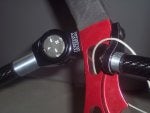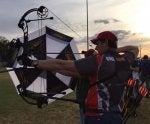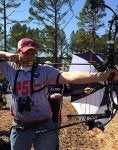I would assume it's just using less weight more efficiently but exactly how does it help the bow?

2,394 posts
·
Joined 2013
I put a 20 degree down on my 3D hunter class bow and it reduced my pin float. Since I use a 10" stab I went with the 20 degree and then added more weight. It seemed lowering the weight helped me be more steady. When you angle the weight down it decreases the effect on the bow as far as weight forward so you will need to add a little more. On a long stab (30" or so) I would use an 8 or 10 degree down.
5,156 posts
·
Joined 2002
The down helps you stop canting the bow. Simple physics because it changes the way the weight hangs. With it below the connection point, it takes more force to get it off center. So the idea is that this helps you hold the bow exactly vertical
2,783 posts
·
Joined 2013
An angled front bar has several possible advantages. By lowering the angle you increase the weights leverage so it acts like you have more weight. So you can use less weight or it can help if your bow has too much side to side wobble. On my target bow it reduced the time for my bow to steady upon draw. An angled bar can also keep stabilizer out of your sight picture.
9,248 posts
·
Joined 2003
If the weight is closer to the bow, it has less moment. It cannot act like more weight. Angling the stab brings the weight closer to the bow. The theory is that gravity will act to rotate the bow back to vertical if the angled stab is canted.
25,937 posts
·
Joined 2010
I shoot with both a straight quick disconnect and a 10 degree one and really can't tell a difference in accuracy or float pattern. I do like the 10 degree better as far as the looks of the bow and I like the fact that when I come up to draw the bow the weights aren't in my sight window as I draw.
Get a b-stinger 10 degree and just try it, they are well made and get the job done.
Get a b-stinger 10 degree and just try it, they are well made and get the job done.
11,388 posts
·
Joined 2006
Like to know too.
Did some testing, so far doesn't seem that much of difference with the front 10 degree before the shot. (Don't really care for the look of the 10 degree.)
Some says the bows settles down quicker after the shot. I'm more interested before the shot.
Did some testing, so far doesn't seem that much of difference with the front 10 degree before the shot. (Don't really care for the look of the 10 degree.)
Some says the bows settles down quicker after the shot. I'm more interested before the shot.
3,821 posts
·
Joined 2002
Typicaly the bow settles down quicker when you come to full draw rather than after the shot...
3,821 posts
·
Joined 2002
Check out the attached pic.. Absolutely there are advantages to angled stabs.. As skisme said.. One the biggest is the amount of leverage one gains with out actually increasing the length or adding weight to the front of the stab.. Essentialy a stabalizer can be viewed as a moment or leverage arm.. and the further to locate the end mass away from the pivot.. the greater influence it has...
Attachments
-
38.4 KB Views: 3,165
38,240 posts
·
Joined 2006
These two about sums it up. I have a straight 30" front stab with 1" straight quick disconnect and a 30" front stab with 1" 10 degree down quick disconnect. Both tried on one bow, the 10 degree does make a nice difference. Just now trying 10 degree down on second bow and results are that of being more stable. Like ron noted something of centering bow mass in gravity terms.....pendulum effect,...the weight wants to settle to the bottom of the radius made by the distance in offset between the point that the stab attaches to the bow and the lower position of the weight at the end of the stab.
it helps by dynamically putting the bow in a vertical position.
one of the fairly little known facts about down stabs, is that they can be offset to correct a slight natural cant because gravity will try to pull the weight to the farthest low position attainable. when the stab is slightly off set, the weight is not at the bottom of the above mentioned radius, so gravity tries to correct the cant by pulling the weight to the lowest possible position.
3,821 posts
·
Joined 2002
I actually designed and produced a version of an angled stabilizer mount back in the day that allowed the shooter to customize or change the setting in 2 degree increments ranging from 0-30 degrees... Its pretty amazing how a simple angle change can influence the hold or float pattern of a bow...
Attachments
-
59.3 KB Views: 1,205
457 posts
·
Joined 2013
That's pretty sweet. Would definitely be a good tool to test what angle and weight works best for the shooter.
11,388 posts
·
Joined 2006
Technically on paper it should make a difference.
But from the subjective point of view, how much better is the 10 degree down from the scale of 1 to 10? How much tighter are your groups with the 10 degree?
But from the subjective point of view, how much better is the 10 degree down from the scale of 1 to 10? How much tighter are your groups with the 10 degree?
3,821 posts
·
Joined 2002
Groups are are a direct result of the archers ability to hold and execute on target... This is just a tool that will influence that hold or float.. Its not scalable...
25,937 posts
·
Joined 2010
I have a feeling that if I had a product like that one where I could see the affects instantly on the float pattern I would be able to actually benefit from picking the right one. For me I never actually got to really test back and forth and make a good decision.
2,394 posts
·
Joined 2013
Actually it acts like less weight. When I put the 20 down on my bow sat straight up after the shot. I added more weight to get it to roll forward again like I want it to. It makes since if you think about it, by angling down the weight comes closer to the bow and changes the balance back to the shooter.By lowering the angle you increase the weights leverage so it acts like you have more weight.
2,783 posts
·
Joined 2013
No a 10 degree down lowers the center of gravity and acts like more weight. If you have a lot of weight on your front bar you won't notice much difference, but if you are using 3-6 ounces on a 30" bar it can make a difference. For me, it greatly reduced my bow waggle when I hit full draw and allows my shot sequence to happen a little faster.
245 posts
·
Joined 2012
I run a 20 degrees down on my front bar. The only noticeable difference for me was the vertical stability. Lower center of gravity=easier leveling of sight bubble. Just like a pendulum if the weight is lowered it wants to hang down. But as far as actually changing scores I really don't think there is a difference, it's just a feel thing. I like it, and like has been said not seeing the stabilizer in my sight picture is preferred. I would suggest trying it, you may just like it. But certainly don't expect your scores to change as a result. However if it somehow feels right it could boost the mental confidence which could lead to better executed shots and therefore better scores. Feeling comfortable with ones equipment can improve shooting, not because the equipment is actually working better, but because we can take our focus off the equipment and focus on what really matters which is making good shots.
245 posts
·
Joined 2012
Okay let's clear up the "acts like more weight.....acts like less weight". As the stabilizer moves lower it moves closer to the shooter in regards to the horizontal plane. But it moves further from the shooters hand or pivot point in relation to the vertical plane. So in the horizontal plane it is effectively lessening the MOI (not what we want in a stabilizer, we always want to increase MOI). But in the vertical plane we are increasing the MOI which we want. So if stability is lacking in one area we can direct the stabilizer to compensate for it. So if the stabilizer is pointed down we decrease its leverage in the horizontal but increase its leverage in the vertical. So it acts both "heavier"and "lighter" depending on the plane we are referring to. Lighter in the horizontal, heavier in the vertical. If this doesn't make any sense grab a broom by he handle and just try moving it in different directions as you try starting from different angles. I believe it will become apparent what is happening. Good shooting!
457 posts
·
Joined 2013
For me, The difference in a straight bar vs. (lets say) a 10 degree bar, is that my float pattern becomes less agile. Meaning that it is more sluggish and sloshes around in the 10 ring slowly. If I use a straight bar with no down angle, my float pattern speeds up and "dances" more quickly in the area of impact.
Another benefit that I have noticed since switching to the angled mount is that during, and after the draw cycle, the bow comes to a better vertical level quicker than with a straight bar. This is just my experience with the angled mount and it may not effect everyone the same. There are a lot of variables that come into play. (Form, weight orientation, bow brand, even DL.) These were just my results, if that helps any.
Another benefit that I have noticed since switching to the angled mount is that during, and after the draw cycle, the bow comes to a better vertical level quicker than with a straight bar. This is just my experience with the angled mount and it may not effect everyone the same. There are a lot of variables that come into play. (Form, weight orientation, bow brand, even DL.) These were just my results, if that helps any.
6,289 posts
·
Joined 2010
I've shot with both extensively on a 36" bar. I shoot a 57-58X average so I would easily notice a difference between the two. I didn't really see an advantage as far as hold, or scores, but where I did make a preference was with the end of the stabilizer being removed from my sight picture.
8,834 posts
·
Joined 2013
pendulum effect,...the weight wants to settle to the bottom of the radius made by the distance in offset between the point that the stab attaches to the bow and the lower position of the weight at the end of the stab.
it helps by dynamically putting the bow in a vertical position.
one of the fairly little known facts about down stabs, is that they can be offset to correct a slight natural cant because gravity will try to pull the weight to the farthest low position attainable. when the stab is slightly off set, the weight is not at the bottom of the above mentioned radius, so gravity tries to correct the cant by pulling the weight to the lowest possible position.
it helps by dynamically putting the bow in a vertical position.
one of the fairly little known facts about down stabs, is that they can be offset to correct a slight natural cant because gravity will try to pull the weight to the farthest low position attainable. when the stab is slightly off set, the weight is not at the bottom of the above mentioned radius, so gravity tries to correct the cant by pulling the weight to the lowest possible position.
2,790 posts
·
Joined 2005
Well, time to bring out the angled disconnect and try it again.....subscribed
283 posts
·
Joined 2014
Nothing that you couldn't do by adjusting the length of you stabilizer. The advantage comes from not having to buy tons of different length stabs. As far as shooting it all in your head.
38,240 posts
·
Joined 2006
Not that I'm disagreeing with you, but I am, target bows especially. Longer stab, less weight on end gives the same effect as a short stab with more weight on the end. Not uncommon is buying a longer than needed front stab and cutting it shorter. Weights distributed for best effect and longer and more accurate shooting is gained. Bow best weighted for the shooter the harder the bow is to move at the shot, giving that little more accuracy.
Not seen often these days is the deflexed riser. These bows want to tip back and longer stabs with more weight sure helps...
Hunting bows. Stabilizer inclined as I am for my target bows, my hunting bow has only a front 8" stab, one of the most copied stabs on the market today in one form or another, the NAP Shock Blocker. Mine is something of 15 years old and works as good as new, rubber mounted, hydraulic action of some type inside.
Awesome are the Pro shooters and their stab set up. The back bars here look as long as one of my front bars. Who's argue with one the top shooters in the nation, Tim Gillingham. One picture showing his 10 degree down and a better picture of his long back bars.
Not seen often these days is the deflexed riser. These bows want to tip back and longer stabs with more weight sure helps...
Hunting bows. Stabilizer inclined as I am for my target bows, my hunting bow has only a front 8" stab, one of the most copied stabs on the market today in one form or another, the NAP Shock Blocker. Mine is something of 15 years old and works as good as new, rubber mounted, hydraulic action of some type inside.
Awesome are the Pro shooters and their stab set up. The back bars here look as long as one of my front bars. Who's argue with one the top shooters in the nation, Tim Gillingham. One picture showing his 10 degree down and a better picture of his long back bars.
Attachments
-
33.6 KB Views: 673
-
78.6 KB Views: 625
13,027 posts
·
Joined 2015
Maybe I failed physics, but an angled front stab would decrease the weight's effect on the "front-to-back" [not sure how to describe it otherwise] orientation. The weights/stab length work like a torque arm, and an angled connection brings the weights closer to the riser in a horizontal plane. Imagine breaking lugnuts loose and where you get the best leverage when pushing/pulling straight down/up. The lower (on a vertical plane) weight would give a "pendulum" type effect and [if lined up correctly] give more of a vertical feel. Thinking you could also cant the down angle to one side or the other to counteract a bow's natural tendency to roll left/right.
Personally, I only use my long stab as a blind person's white cane when finding my foot locators, and as a "bow stand" when waiting/preparing for my next shot... an angled bar would make these more difficult.
Personally, I only use my long stab as a blind person's white cane when finding my foot locators, and as a "bow stand" when waiting/preparing for my next shot... an angled bar would make these more difficult.
13,027 posts
·
Joined 2015
WOW did I ever have a blind moment! I don't usually like to repeat other posts without some point, and somehow I missed all those who already said everything I THOUGHT I was contributing.
8,834 posts
·
Joined 2013
the reduction of effective weight come by the fact that he stabilizer represents the hypotenuse of a triangle, therefore places the weight at a slightly shorter distance from the riser than if the stab was in horizontal position. that reduction of effective leverage against movement, is small,..... almost unperceivable. one of those conditions that show up on paper with numbers, but in realistic terms, close to nothing.
11,388 posts
·
Joined 2006
It's very individual based. Some finds it helpful, some not so much. Tried it and I prefer straight front stabilizer.
Try it and find out for yourself.
Try it and find out for yourself.
262 posts
·
Joined 2010
Straight from Bernie's mouth, it does nothing for balance, like others have said it keeps long stabs out of your sight picture. Any performance gains are realized because you think it helps, and we all know archery is a mental game. If you think a change helps your shooting it probably will.
-
?
-
?
-
?
-
?
-
?
-
?
-
?
-
?
-
?
-
?
-
?
-
?
-
?
-
?
-
?
-
?
-
?
-
?
-
?
-
?
- posts
- 39M
- members
- 242K
- Since
- 2001
A forum community dedicated to bow and crossbow owners and archery enthusiasts. Come join the discussion about optics, hunting, performance, troubleshooting, styles, reviews, accessories, classifieds, and more!








